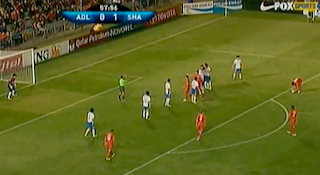The following incidents occurred during the Adelaide United and Shandong Luneng Asian Champions League group match on Tuesday 27 April 2010. Adelaide are a goal down and are desperately seeking the equalizer. The match ended 0—1, but not without two stamping incidents.
The first incident is serious gamesmanship by the Shandong goalkeeper in the 89th minute. Adelaide #9 Van Dijk’s challenge was genuinely for the ball and he purposely kept his feet and studs down (otherwise he would have made contact with the goalkeeper and caused injury, especially with a studs up challenge), but the goalkeeper deliberately stamped on his opponent. Here are the freeze frames.
The second incident is also gamesmanship, this time by Adelaide (red) #18. It occurs in the 90th minute, straight after the first incident. Adelaide #18 (red player in the middle of the screen) deliberately uses his right foot to stamp on the goalkeeper’s left foot and then pushes his own teammate Van Dijk into the goalkeeper whilst keeping his right foot on the goalkeeper’s left foot. Here are the freeze frames.
 [Adelaide United’s Van Dijk is literally “caught in the middle” and the referee cautions him, while the real culprits of violent conduct escape]
[Adelaide United’s Van Dijk is literally “caught in the middle” and the referee cautions him, while the real culprits of violent conduct escape]Ultimately, Adelaide United’s Van Dijk is hard done by. He receives a caution, first, for being wrongly blamed for a confrontation with the Shandong goalkeeper (after the goalkeeper deliberately stamped on him) and, second, for being wrongly accused of pushing the Shandong goalkeeper to the ground (when it was his teammate who deliberately stamped on the Shandong goalkeeper). Will video evidence be used against the real culprits of violent conduct (i.e. the two stamping incidents)?
Related Posts (Stamp Out Stamping)
FA Hands Adebayor Three-match Ban For Stamp on van Persie
Emmanuel Adebayor Stamped And Kicked Robin Van Persie's Head
Belgian Player Gets 11-Match Ban For Shocking Horror Tackle
























































